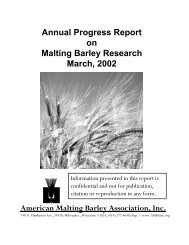Annual Progress Report on Malting Barley Research March, 2007
Annual Progress Report on Malting Barley Research March, 2007
Annual Progress Report on Malting Barley Research March, 2007
You also want an ePaper? Increase the reach of your titles
YUMPU automatically turns print PDFs into web optimized ePapers that Google loves.
ligated to GenomeWalker (Cl<strong>on</strong>tech Laboratories, Mountain View, CA) adaptors to<br />
produce GenomeWalker libraries. Using gene specific primers, based <strong>on</strong> the 5’<br />
regi<strong>on</strong>s of cDNA sequences and two kinds of GenomeWalker adaptor primers, PCR<br />
amplificati<strong>on</strong>s were performed using general c<strong>on</strong>diti<strong>on</strong>s. PCR products were cl<strong>on</strong>ed<br />
and sequenced. A search for putative cis-acting DNA elements with sequences<br />
homologous to the sequences of the cl<strong>on</strong>ed products was performed using the PLACE<br />
(Plant cis-acting Regulatory DNA Elements) database.<br />
Preparati<strong>on</strong> of peptides and antisera<br />
Synthetic peptides were commercially prepared (Anaspec, Inc., San Jose, CA) to<br />
limited regi<strong>on</strong>s (about 15 amino acids) of deduced amino acid sequences of the four<br />
highly expressed α-glucosidases. We selected <strong>on</strong>e regi<strong>on</strong> of each of the four proteins<br />
that we determined to be unique to that protein and that we predicted to be antigenic<br />
based <strong>on</strong> the extent of it’s hydrophobicity. Synthetic peptides were c<strong>on</strong>jugated with<br />
keyhole limpet hemocyanin then used to produce antibodies specific to the four<br />
isozymes of α-glucosidase from barley. Polycl<strong>on</strong>al antibodies to those c<strong>on</strong>jugated<br />
peptides were produced in rabbits.<br />
Western blots<br />
Crude protein extracts were made from barley tissues using the protocol of<br />
Tibbot et al. (1998). Briefly, the seeds or leaves were ground to a fine powder with<br />
liquid nitrogen in a mortar. Approximately <strong>on</strong>e gram of ground tissue was suspended<br />
in 1 mL of buffer c<strong>on</strong>taining 50 mM Na2CO3/NaHCO3 (pH 9.0), 1 M NaCl, 1% Trit<strong>on</strong>-<br />
X100, 2 mM β-mercaptoethanol and 1% protease inhibitor cocktail for plant extracts<br />
(Sigma, St. Louis, MO, USA). Suspensi<strong>on</strong>s were shaken gently for 1 hr at 4°C. The<br />
homogenates were centrifuged at 12,000xg for 10 min at 4°C. Four mL of 50 mM<br />
sodium succinate buffer (pH 4.5) were added to the supernatants, which were then<br />
dialyzed against the same buffer. After dialysis, extracts were centrifuged again to<br />
obtain samples for Western blot analysis. Proteins in these supernatants were<br />
resolved by SDS-PAGE, transferred to polyvinylidene fluoride membranes and probed<br />
with the rabbit antiserum. Detecti<strong>on</strong> of cross reacting proteins were determined using<br />
118
















